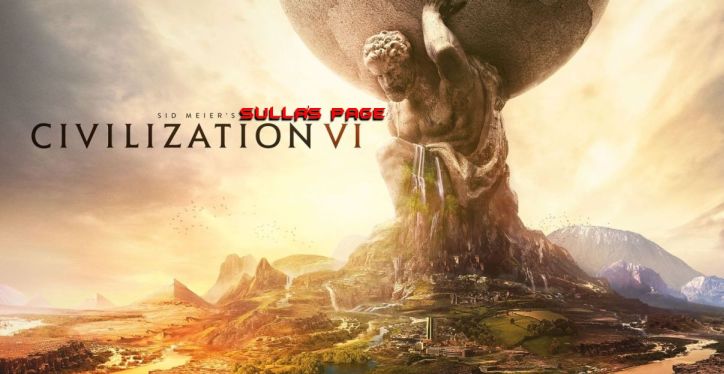

On the last page of this report, The Black Sword had conquered two of his nearby city states with horseman units while narrowly losing out on a third to TheArchduke's Russia. These two civs were incresingly being drawn into conflict with one another as they started pulling away from the rest of the pack of competitors. For the moment, TBS was content to continue building and developing his Cree civilization without having a larger strategic plan in mind:

|
The Black Sword: |
As usual for one of TBS' big overview posts, there was a lot going on that deserves further commentary. The plan for the moment was adding lots of buildings across Cree territory, particularly Campus and Harbor districts. The Campus districts were self-explanatory as a way to increase science output and TBS had started running the Natural Philosophy policy that doubled the adjacency bonus for Campus districts. This is a more important policy in the Civ6 expansions since the Rationalism policy was significantly nerfed and there are more ways to get adjacency bonuses for Campus districts (geothermal vents, reefs, the Government Plaza, etc.) Harbor districts unlocked more of those disgusting Cree trade routes with their 7 food and 4 production yields, and of course Harbor districts and their associated buildings can now be constructed with a 30% production bonus thanks to the improved Veterancy policy in the expansions. Harbor districts were pretty terrible on the release of Civ6 and have been massively buffed over time, to the point that Harbors are now arguably stronger than Commercial districts. Gathering Storm adds +3 housing on completion of a lighthouse if the Harbor district is placed next to the city center tile, making dry coastal cities far more viable than they were in pre-expansion days. Thanks to the Veterancy policy and the nerf to Commercial city states that requires a market to get the gold bonus, TBS was preferring Harbors over Commercial districts across his territory.
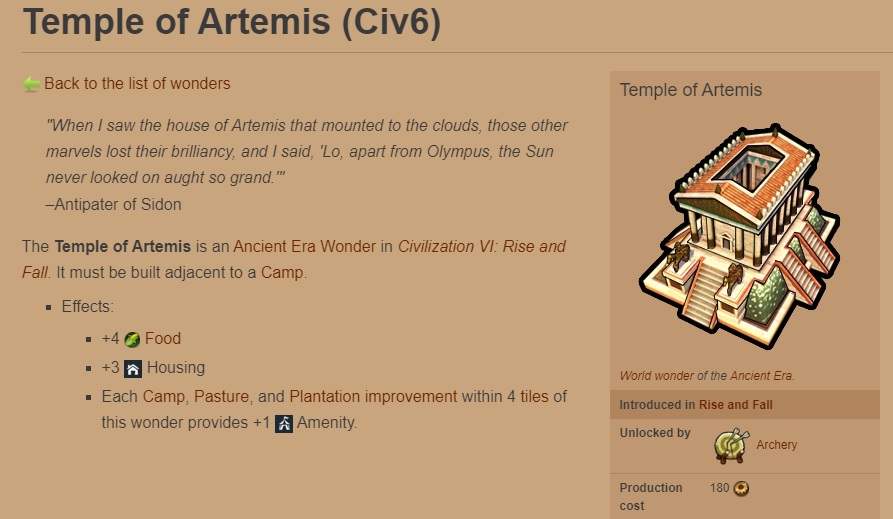
TBS also built the Temple of Artemis wonder in his capital during these turns. This is one of the wonders added to Civ6 in the first expansion and one of the few of them worth building. It's a situational wonder that provides food and housing to a single city along with additional amenities based on nearby camp, pasture, and plantation improvements. TBS was constructing the wonder for the amenities bonus, and the game had advanced far enough that it was worthwhile to spend 180 production in return for the seven amenities that would be gained via this wonder placement. (TheArchduke had also been considering this wonder and didn't have an opportunity to build it in time.) The big problem for wonders in Civ6 is that they are rarely worth the opportunity cost of building them as opposed to something else. TBS had enough production in his capital that he could afford to land something that was a bit of a luxury good.
Diplomatically, TBS had renewed another Declaration of Friendship with Cornflakes' Rome to lock in another 30 turns of peace. TheArchduke had also offered another Declaration of Friendship but it was not accepted by TBS, leaving the two of them open to conflict at any point in time. TBS was directing his research towards Cartography and Square Rigging at the top of the tech tree to unlock caravels and frigates, along with Military Engineering to reveal the nitre which would be required to construct those frigates. Control of the seas would open up potential opportunities to attack Russia or alternately to capture the Scientific city states located out in the ocean to the west. However, this was where TBS ran afoul of one of the rules agreed upon prior to the game's start:

|
The Black Sword: |
One of the out-of-game rules that the players had agreed upon prior to starting was that a city state could only be attacked if war was also declared against its suzerain. City states like Mohenjo-Daro and Jerusalem and Cardiff had all lacked suzerains and therefore had been fair game for anyone who wanted to stomp them out. Hattusa was different though because Alhambram was the suzerain and TBS literally could not declare war by virtue of having a Declaration of Friendship with his civ. Furthermore, it wasn't even clear if it was a good idea to declare war on Alhambram since he was playing as Australia and would instantly received +100% production for the next 10 turns by virtue of Australia's (very poorly designed) innate ability. TBS ultimately decided it would be better to invest more envoys into the Scientific city states and start reaping the additional beakers in his own Campus districts (the ones with libraries finished anyway) as opposed to trying to burn them down.
With Alhambram's Australia starting to factor into the diplomacy of the main continent, this is a useful point in time to pause and briefly recount what had taken place on the other continent. There were three players who started over there: Alhambram's Australia, pindicator's Khmer, and suboptimal's Nubia. Alhambram found the two Scientific city states early on and scored the free envoy with both, eventually building his civ vertically with three very powerful cities in his core. The one problem: he failed to expand outwards by building more than those three cities!

Alhambram was stuck on three cities as late as Turn 75 at a point when the other game leaders like TBS and TheArchduke were sitting on eight cities. He double expanded with Adelaide and Newcastle to get up to five cities but was still inexplicably parked there as the game approached the 100 turn mark and TBS was about to hit double digit city count. Yes, the Canberra/Hobart/Geelong trio were fantastic cities with lots of completed districts, and yes, it was impressive to be pulling 78 beakers/turn from only five total cities. However Civ6 is not Civ5 and it is very much a game of outwards horizontal expansion. Alhambram's failure to settle the extremely fertile region to the northwest of Hobart didn't make a lot of sense, nor did the rationale behind placing Adelaide and especially Newcastle so far away from the other cities. The presence of Uluru up there in the northern desert shouldn't have been that big of a draw, even if it was thematically appropriate when playing as Australia. Attacking and capturing some of the nearby city states also would have been a big help; I don't think that there was any need to keep them alive for the district bonus on Militaristic or Industrial districts. Alhambram himself mentioned later that he thought he had gotten too caught up in building districts and pushing science/culture/gold rather than training additional settlers for expansion. Australia was isolated and able to focus purely on infrastructure, then ended up getting a bit too invested in creating lovely cities full of different districts.
So what about the other two players then? If you look at the stats below the little portraits in the last screenshot, it should quickly become clear that Nubia and the Khmer were far behind everyone else in the game. The reason: they'd been engaging in a mutually destructive war ever since the early stages of the game. Suboptimal planned a military rush using Nubia's Pítati Archer unique unit and pindicator was the unlucky target of that rush. A flood of those archers did succeed in capturing pindicator's second city back on Turn 47:
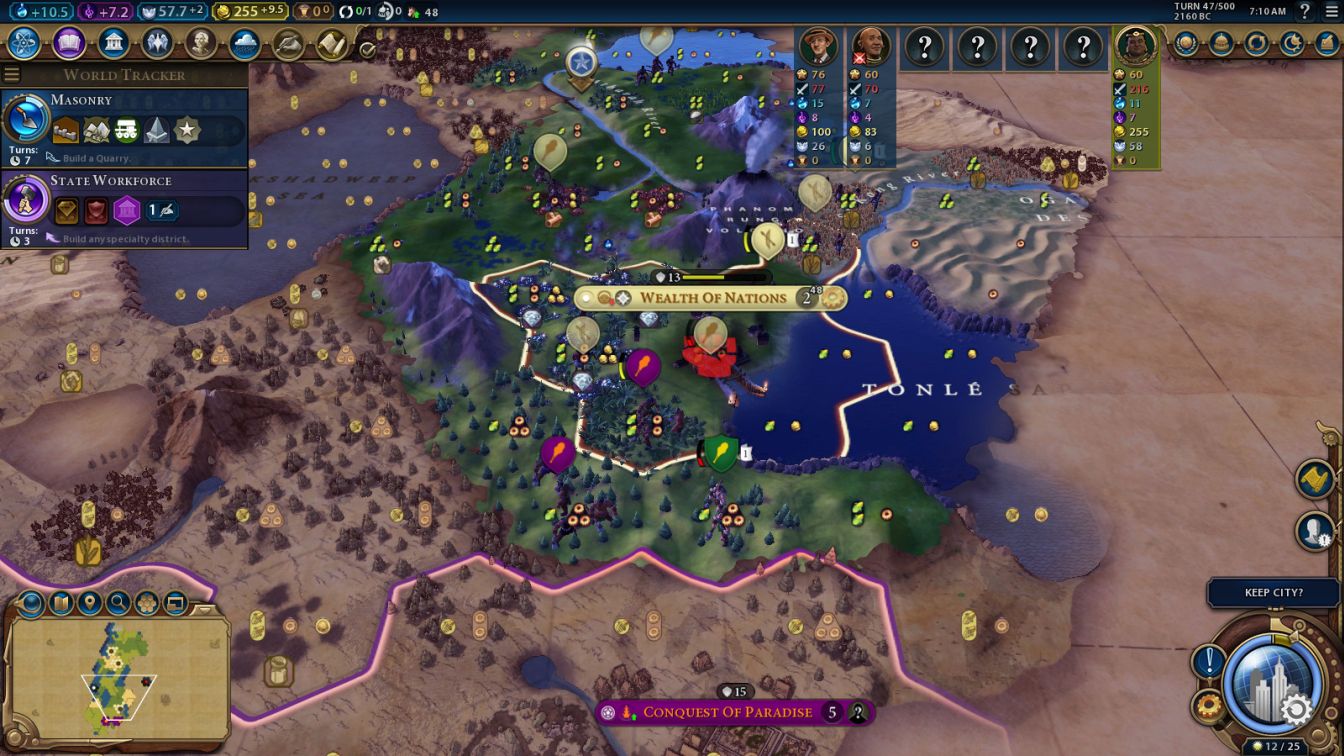
But that was only the start of the war, not the end of it, and pindicator had no intention of meekly signing peace to recognize the loss of his city. Captured cities are nearly useless in Civ6 thanks to the occupancy mechanic, not becoming productive until after a peace treaty is signed or the original owner is completely conquered. This situation is made even worse in Gathering Storm thanks to the worst feature added in the expansions: the loyalty mechanic. Loyalty causes any cities captured or settled too far away from the player's capital to suffer from "disloyalty", eventually revolting away from the owner and becoming independent city states of their own. This might sound fun and interesting in the abstract, and perhaps it can be entertaining in a Single Player context, but it's disastrous for Multiplayer since it makes conquest nearly impossible. Wealth of Nations (renamed to Au Gratin) was almost 20 tiles away from the Nubian core and it was impossible for suboptimal to hold the city for any length of time thanks to the loyalty penalty. Having chosen to keep the city, he also couldn't raze or abandon the location either, and eventually was forced to leave the area and let pindicator recapture the place. Furthermore, suboptimal had stopped producing more units after his initial attack, and by the time that he resumed training more Pítati Archers, they had ages of walking to reach the front lines thanks to the crazy logistics of fighting a war over that huge distance. It was a major mistake to take the proverbial foot off the gas pedal too soon.
The result was a long and unproductive stalemate, dozens of turns of archers and warriors and horsemen getting killed on both sides of the Nubian/Khmer war to little effect. Both suboptimal and pindicator ended up as broken, crippled civs as compared to the rest of the world, stuck in Ancient era barbarism long after the other empires had advanced beyond those early days. Suboptimal's Nubia was indeed winning the war ever so slowly, reconquering Wealth of Nations for a second time on Turn 94:
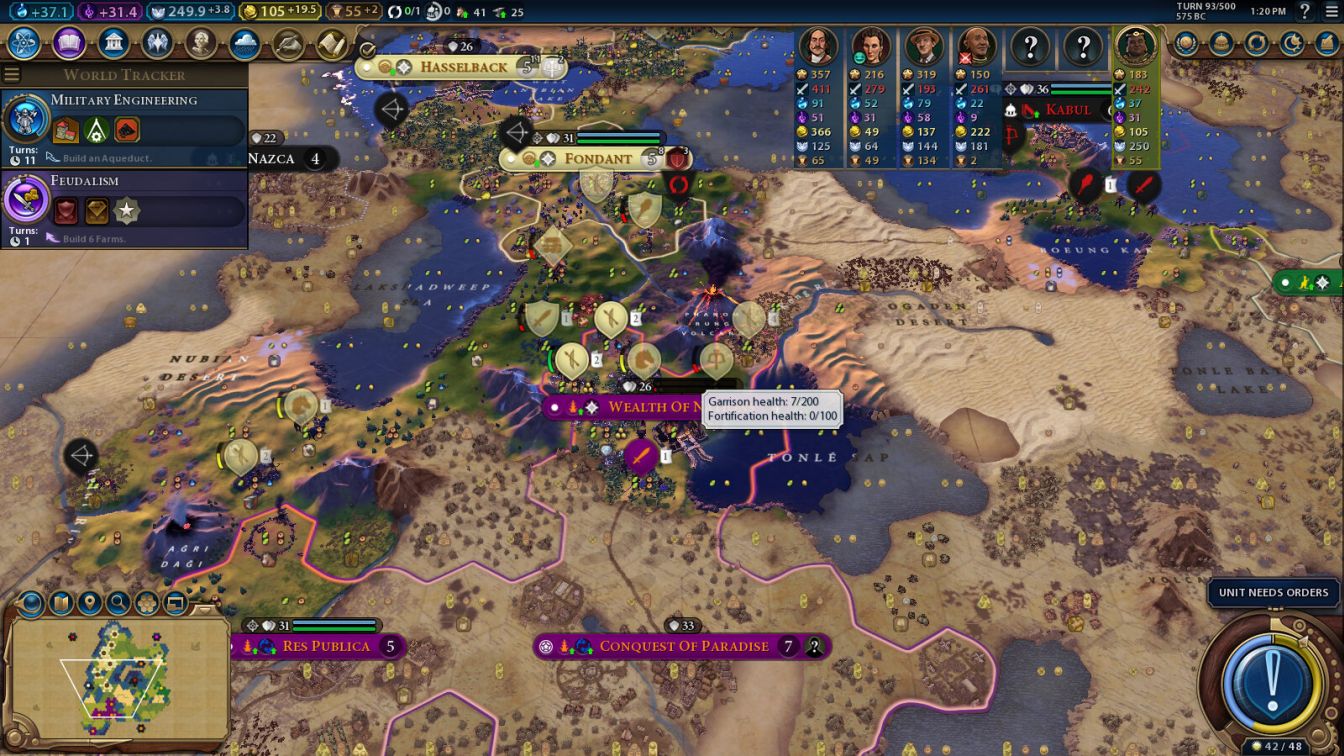
And this time he razed the city to the ground to avoid dealing with the loyalty mechanic. But what had this really achieved? Fifty turns of warfare to raze another player's city without even having any captured territory to show for it? Meanwhile, Nubia was stuck at 37 beakers/turn and 31 culture/turn at a time when TBS and TheArchduke were about to top the 100 beaker mark. I guess that was better than poor pindicator's situation, with the Khmer producing a mere 22 beakers and 9 culture each turn. Still, the whole thing felt like one of those early game AI vs AI wars from our Civ4 AI Survivor matches, where Montezuma rams a series of axes and chariots into defenders protected by city walls. Lots of mutually assured destruction for no purpose. Pindicator had no choice in the matter as the one attacked but suboptimal would have done better to choose a different path in this game.
The net effect of all of this in the wider picture was that the civs on the other continent held relatively little strategic importance. Nubia and the Khmer were hopelessly backwards and would never be competitive. Their territory wouldn't even be that useful for a would-be conqueror because it had been so heavily fought over and lacked much in the way of development. Australia superficially looked decent at the moment but wouldn't be able to keep up in the long run to due to lack of expansion. It was almost inevitable that Alhambram's research rate would start to lag behind with only three Campus districts available as compared to TBS and TheArchduke who were pushing half a dozen already and with more of the same districts under construction. The outcome of the game would be decided by the players on the larger continent with little involvement from the other three empires.
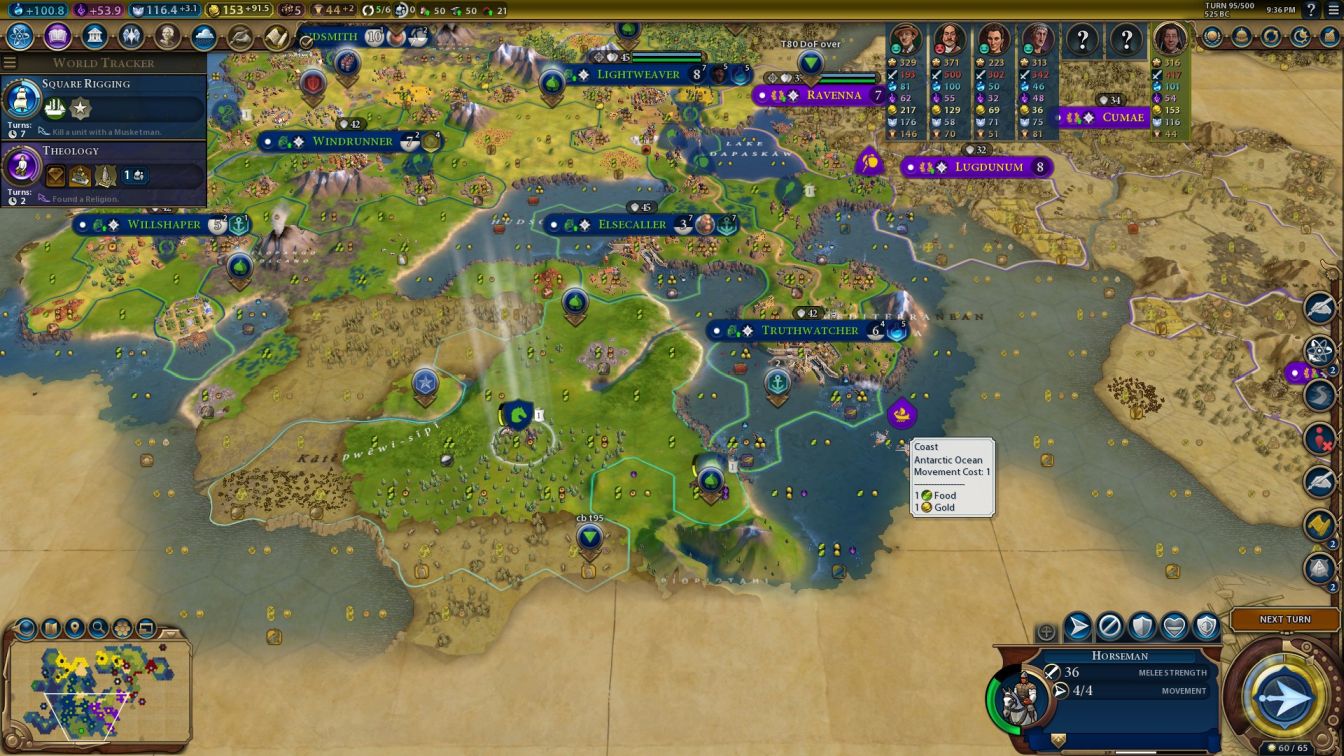
Meanwhile, TBS had nine cities already (seven settled and two captured from city states) and three settlers en route to establish three additional settlements. He had done an excellent job of building the settlers in waves throughout the game, minimizing the time spent in Colonization policy to allow other useful policies to be run in the Economic slots. (TBS actually didn't talk too much about which policies he was running in his spoiler thread and I had to do some inferring from screenshots in putting this report together.) In contrast to the vast open spaces on the smaller continent, most of the larger continent had been claimed by one of the four players by this point in time, with the remaining Cree settlers filling in some of the gaps in the deep south. A lurker asked TBS what win condition he was aiming towards and received this response:
|
The Black Sword: |
TBS might not have had a defined win condition but he did have a solid strategic plan. TheArchduke wasn't far away from unlocking cossacks and they would be terrifyingly strong units when they arrived, 67 strength units with an additional +5 strength within their own territory or adjacent to it, and then another +5 strength when fighting in Russian territory thanks to Defender of the Faith from TheArchduke's religion. Cossacks also have 5 movement points and can move after attacking, unique amongst units in Civ6, allowing them to hit and run to kill enemies without ever putting themselves in danger. TBS couldn't match the cossacks on land and therefore sought to confront Russia at sea instead, where the Cree could expect to have a tech advantage and superior numbers thanks to having more cities with ports. If it wasn't a strategy for winning the game, it was at least a plan to weaken and harass the biggest competitor.

This picture from Turn 96 showed the tenth Cree city to be established at Stoneward. The more zoomed-in nature of this screenshot makes it easier to see the local terrain, and I want to emphasize again how TBS had stayed on top of his builder micro such that his cities were working almost entirely improved tiles. The tiles over at Dustbringer were pretty disgusting thanks to the Goddess of the Hunt pantheon on camps and a nitre resource popping up in a friendly spot. Note in the bottom-right corner of the screen that TBS had also been diligently chasing after era score and was only four points away from triggering a Golden Age in the upcoming Medieval era. This would be highly significant since one of the dedications would be a perfect fit for his civilization; more on this later. Pen, Brush, and Voice had been doing a fantastic job of keeping the Cree culture going strong throughout the Classical era despite the civ not having any innate culture-generating abilities and zero Theatre districts completed as yet.
TBS provided a big empire-wide update for Turn 100 which I'll borrow from liberally here in this report:
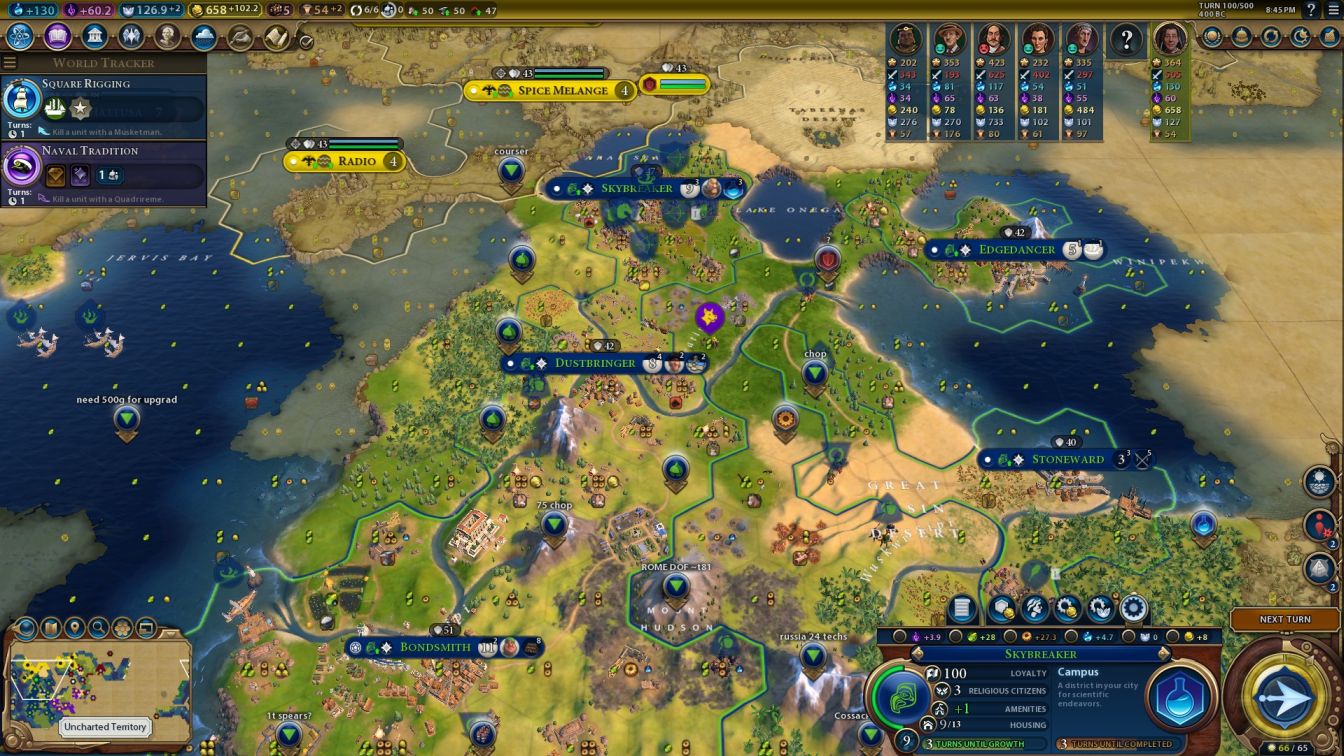
|
The Black Sword: |
Most of TBS' attention was focused on preparing for an attack on Russia at sea and defending against the impending cossacks on land. However, even with much of the empire building naval units as fast as possible, the southern Cree cities continued to work on their infrastructure at a frightening rate. The trade routes were an enormous component of this larger project, infusing newer cities like Willshaper and Stoneward with massive amounts of food and production to get them off to a roaring start. These new cities also began with a free builder (which would start with five charges as long as TBS made sure to establish cities while in Serfdom policy as he detailed above) and could ignore housing as an issue with a mekewap or two. Each Cree city grew incredibly fast and was soon outputting huge amounts of production. The trade routes were also worth a ton of gold as well; TBS was making more than 100 gold/turn and consistently had far more income than any of the other players in the game. This was a particular problem for TheArchduke who was working with roughly 30 gold/turn at the moment thanks to shouldering the cost of a large military. TBS could train units faster and upgrade them with more advanced technology using his hefty pocketbook.
TBS posted pictured of every city in his empire for the big Turn 100 update. I won't include them all but I do want grab a few of them to highlight their development:
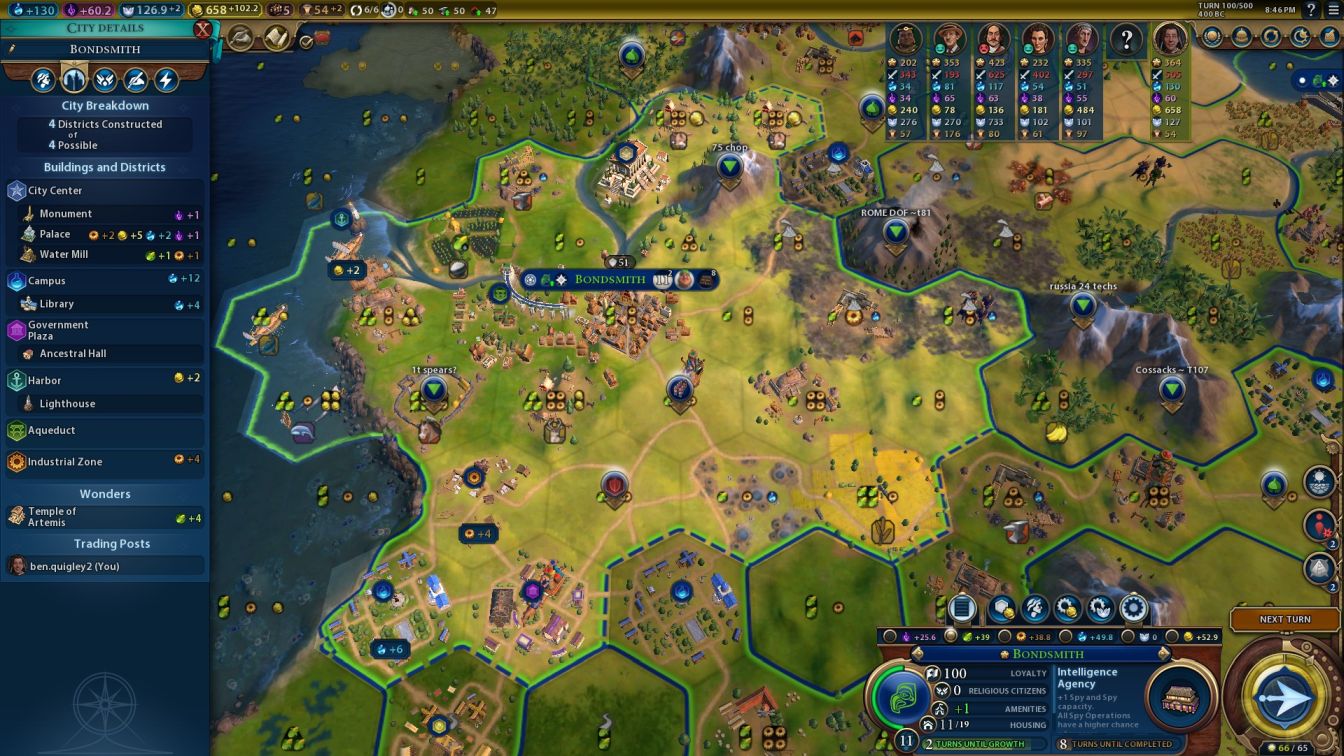
We'll start with the capital of Bondsmith. This was easily the best city in the entire world, sitting at size 11 in population and rapidly growing upwards with +17 food/turn surplus. There were 19 points of housing here thanks to the Aqueduct district (built for the Military Engineering boost, not out of a need for housing) and the Temple of Artemis and a single mekewap located two tiles east of the deer resource. TBS built four different districts here and had an Encampment planned for the fifth which would be unlocked at size 13. (The Encampment wasn't needed for defensive purposes but would unlock some later boosts and provide another +1 production on all trade routes directed to the capital.) The biggest key to the success of the capital was its production, already sitting at 38 per turn and continuing to grow as the city increased in size. No one else had a capital that could match this kind of production output and it essentially allowed TBS to do anything that he wanted.

Furthermore, it wasn't as though the Cree capital stood out as an anomaly and all of the other cities were noticeably weaker. Instead, every city was a powerhouse of one kind or another. Take the pictured Lightweaver, for example, the third city to be established by TBS on Turn 55. Lightweaver was size 8 and not even remotely close to its housing cap of 15 (!) despite lacking any granaries or aqueducts or neighborhoods. The city was getting its housing from the Cree's mekewap unique tile improvement, three of them in fact: southwest of the city and due west of the center tile and a third in the far north. The mekewaps were just as good as a mine when placed next to a strategic resource, with 1 food / 4 production yield, and they each added 2 housing for free on top of that - completely crazy!  On a fertile map like this with resources everywhere the mekewaps were insanely powerful. Lightweaver therefore managed to reach 35 production/turn and could easily crank out anything that it wanted. Units? No problem. A four turn builder? Sure. How about another district? That might have taken a whole six or seven turns to complete. The build times were so low that it looked like TBS was playing on Quick speed while everyone else was on Normal.
On a fertile map like this with resources everywhere the mekewaps were insanely powerful. Lightweaver therefore managed to reach 35 production/turn and could easily crank out anything that it wanted. Units? No problem. A four turn builder? Sure. How about another district? That might have taken a whole six or seven turns to complete. The build times were so low that it looked like TBS was playing on Quick speed while everyone else was on Normal.
OK, well Lightweaver was still one of the older core cities for the Cree. What about one of the newer cities like Willshaper, which was settled around Turn 80 and had been in place for roughly 20 turns?

Oh come on, that just wasn't fair! In less than two dozen turns, Willshaper grew to size 6 and finished a Campus district + library along with a Harbor district. It was nearly finished with its lighthouse as well and then would be free to train more ships for the greater Cree navy. Willshaper was generating 27 production/turn, 17 beakers/turn, and still growing at +8 food/turn surplus. I can't emphasize enough how much work the various Cree unique advantages were doing here. The trade route was acting as the equivalent of a 9 food / 4 production / 2 gold tile since it provided food that didn't have to be fed like a normal population point would. The double mekewaps allowed the city to keep growing upwards endlessly instead of crashing into the housing cap at size 4 and then having to stop to build a granary or an aqueduct. (*AND* the mekewaps also provided +2 production on their respective tiles as well! They are so freaking good!) TBS was continuing to do a masterful job of pushing the Cree snowball down the proverbial hill, accumulating more and more speed as it went. Yes, the Cree advantages were pretty disgusting in this game, but it still required a skilled hand at the tiller to direct the whole effort.
By way of contrast, let's also look for a moment at TheArchduke's empire on the same Turn 100 date:
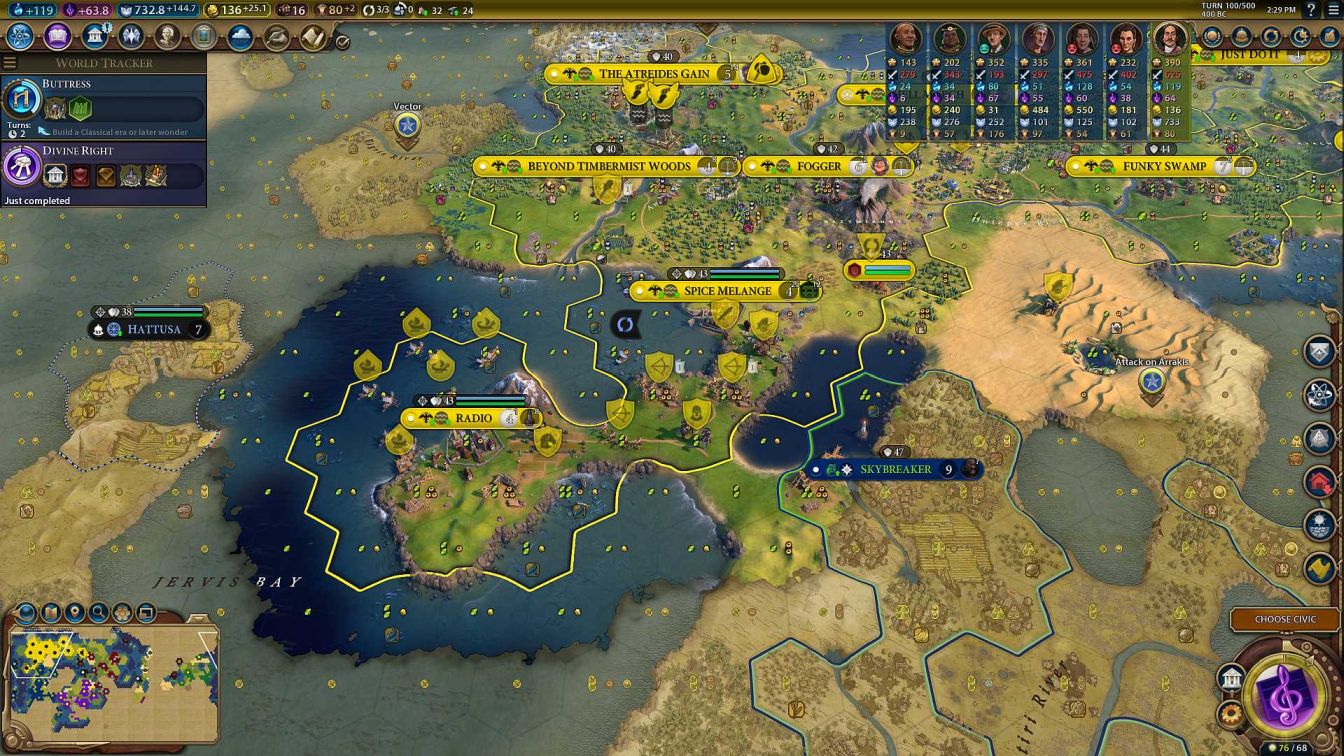
I want to emphasize that TheArchduke was playing a fantastic game in his own right. He was making good use of Earth Goddess + Lavras + Monumentality for a massive income of almost 150 faith/turn, and Russia was heads and shoulders above all of the other civs aside from the Cree. The numbers under the little faces in the top-right corner make it clear that this game was narrowing down to a two-person race for the lead. With upcoming cossacks and Defender of the Faith at hand, TheArchduke was a formidable opponent who looked to be stronger than all of his non-Cree opponents. However, by drilling down and looking at TheArchduke's cities, it was clear that he didn't have the same economic strength as TBS:
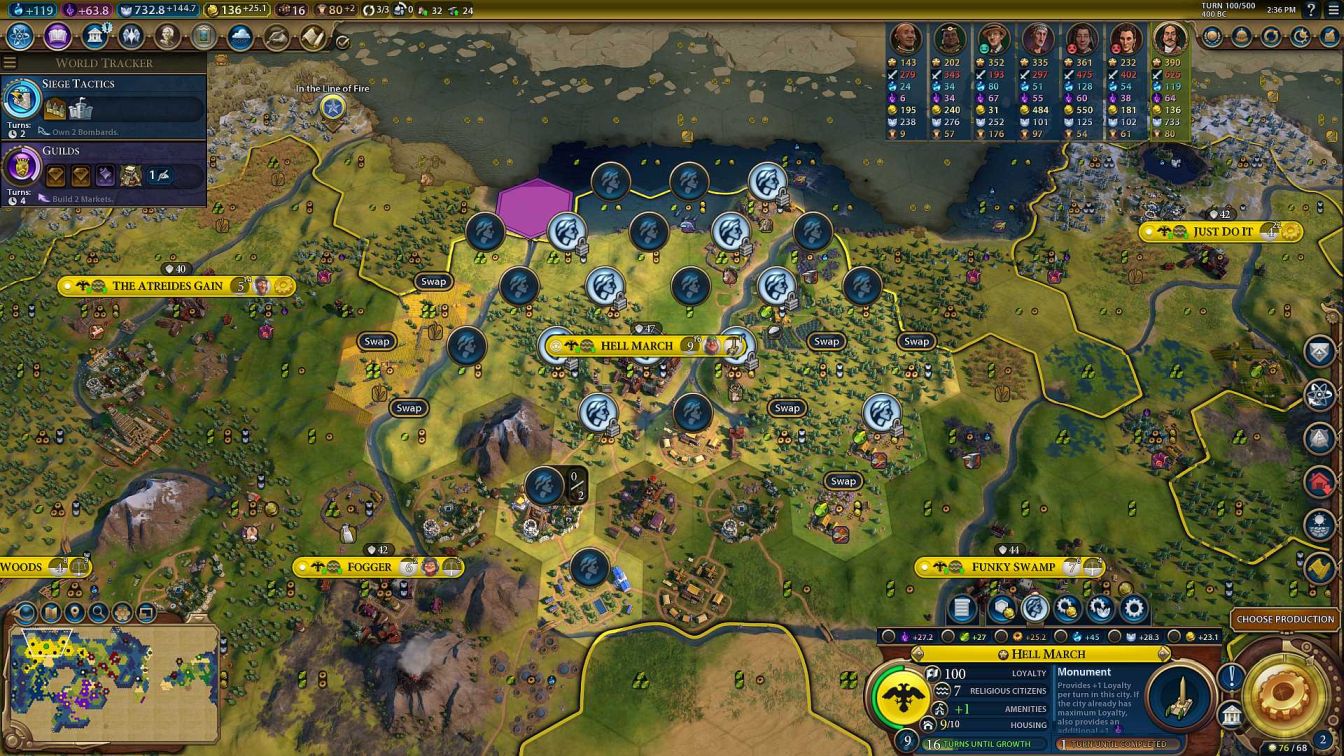
This was the Russian capital of Hell March. It was an excellent city in its own right at size 9 with Lavra, Campus, and Commercial districts finished and the tier 1 building complete in each. The Lavra also had the tier 2 temple building completed for a juicy Choral Music cultural bonus. Hell March was outputting comparable beakers and culture as compared with the Cree capital of Bondsmith and that was no small task. However, the Russian city was two sizes smaller and essentially stuck at size 9 for the forseeable future until an Aqueduct district could be completed. There were no magical mekewaps here to solve the housing issue. TheArchduke's city also had significantly less production, only 25 base hammers as compared with 38 base hammers at Bondsmith, and that was a major difference indeed. TBS could build things 50% faster across the board. The biggest issue was a lack of improved tiles at Hell March where there were many forested hill tiles that had been left untouched. TheArchduke was using Earth Goddess for his pantheon (+2 faith on all tiles with Breathtaking appeal) which meant that he needed to preserve as many forest tiles as possible, but there was nothing stopping Russia from placing lumbermills on many of these spots. Three or four lumbermills at +2 production per improvement would have helped a good deal.

Next, take a look at Funky Swamp, the third city of Russia. This city was established on Turn 43, a dozen turns earlier than Lightweaver, and therefore theoretically should have had more infrastructure. While this city did have three districts completed as compared to two districts at Lightweaver, Funky Swamp was a size smaller and capped on growth for lack of housing (the mekewaps and Cree trade routes at work again). Most importantly, Funky Swamp had only half the production output of Lightweaver, 18 hammers against 35 hammers. TheArchduke had done an overall good job at building this city and in particular it was creating a lot of faith that could be spent on settlers/builders via Monumentality. However, it's just really hard to compete against an opponent who has cities that basically ignore the housing limit and get double your production each turn.
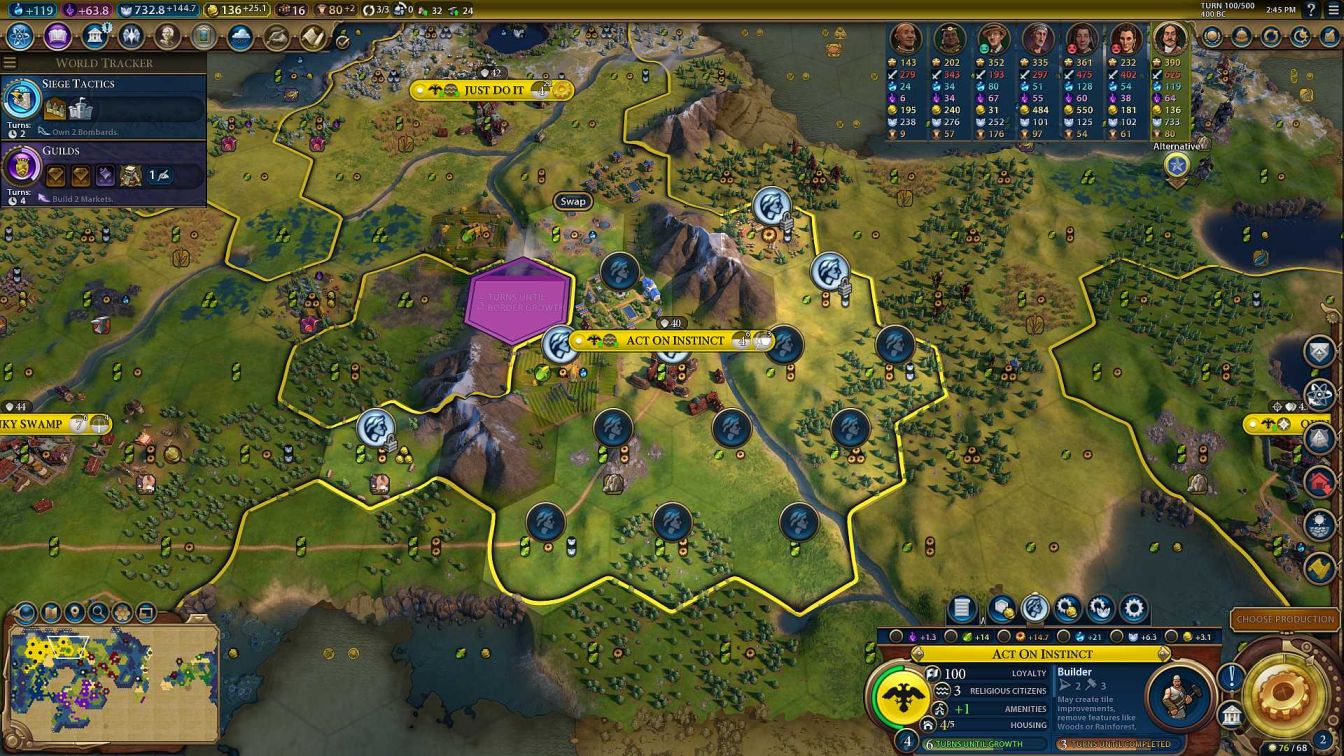
Finally the Russian city of Act on Instinct. This city was founded half a dozen turns before Willshaper on Turn 72 and had slightly more time to develop in comparison to its Cree counterpart pictured above. Despite this fact, Willshaper was two sizes larger, had completed two districts as compared to one, and was outputting fully double the production each turn, 27 hammers as compared to 14 hammers. The Cree city again simply did everything faster by virtue of growing more quickly and having more production available. Again, Act On Instinct was a good city and it was producing a ton of beakers thanks to the +5 adjacency bonus on its Campus district. TheArchduke was not doing a poor job here - quite the opposite, as he was far ahead of everyone else competing in this game. The whole point of looking at these cities is to highlight how quickly the Cree were snowballing ahead of everyone else. TBS knew how to leverage the advantages of his civ choice and he was pushing them for all they were worth.
As a result, by the Turn 100 mark there were two leading civs in the Cree and Russia, followed by two trailing civs in Rome and Australia, and then three also-rans in Greece and Nubia and the Khmer. The first hundred turns of this game had largely been a developmental phase without direct conflict between the major powers. Everyone had been given ample time to build their respective decks and assemble the various cards that they wanted to play. Now it was time for everyone to show their hands and see who would emerge on top as the strongest nation. The building phase of the game was at an end.



